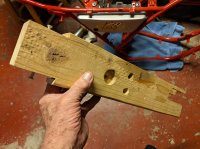Unfortunately, just draining the fork oil doesn't clean out the inside of the lowers very well. It's not like changing engine oil that's real hot and has been churned all around by the gears so much of the sludge build-up is broken up and cleaned out. Fork oil doesn't get hot nor does it get churned around much. The sludge remains just sitting in the bottom of the fork leg. I made up a "special tool" for cleaning the insides of the legs out. It's nothing more than a length of 1/4" rod with a small loop bent in one end that I can thread a rag through .....

I dip the rag in solvent, insert it into the lower, and use it like a ram rod to swab it out .....



I dip the rag in solvent, insert it into the lower, and use it like a ram rod to swab it out .....


 . Kerosene works great and you can get it at most rural gas stations for $4 a gallon.
. Kerosene works great and you can get it at most rural gas stations for $4 a gallon.

